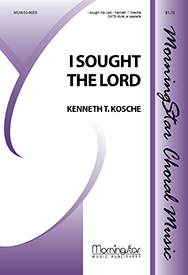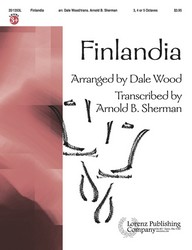A Mixture of Miniatures: Short Organ Pieces for the Service
Composer/Editor
John S. Dixon
Published By:
Lorenz Publishing Company (2022)
pp. 34
The Sacred Organ Library Volume 10
Composer/Editor
Brenda Portman
Published By:
Lorenz Publishing Company (2021)
pp. 37
Easy Organ Library Volume 69
Composer/Editor
Douglas E. Wagner
Published By:
Lorenz Publishing Company (2020)
pp. 96
The Organist Volume 124 Number 3 July August 2020: The Service Music Companion for the Church Organist
Composer/Editors
Carson Cooman; Douglas E. Wagner
Published By:
Lorenz Publishing Company (2020)
pp. 28
The Sacred Organ Journal Volume 54 Number 5 May June 2020: A Bi-Monthly Anthology for Church Organists
Composer/Editors
Carson P. Cooman; Brenda Portman
Published By:
Lorenz Publishing Company (2020)
pp. 11
Peace Like a River: Preludes and Meditations for Organ
Composer/Editor
Brenda Portman
Published By:
The Sacred Music Press (2019)
pp. 23
The Organ Portfolio Volume 82 Number 3 January February 2019: The Service Music Anthology for the Church Organist
Composer/Editors
Carson Cooman; Timothy P. Cooper
Published By:
Lorenz Publishing Company (2019)
pp. 20
The Organist's Library Volume 66
Composer/Editor
Timothy P. Cooper
Published By:
Lorenz Publishing Company (2019)
pp. 88
The Sacred Organ Library Volume 3
Published By:
Lorenz Publishing Company (2018)
pp. 44
The Sacred Organ Journal Volume 51 Number 5 May June 2017: A Bi-Monthly Anthology for Church Organists
Composer/Editors
Carson P. Cooman; Kevin Uppercue
Published By:
Lorenz Publishing Company (2017)
pp. 18
The Sacred Organ Journal Volume 51 Number 5 May June 2017: The Organist's Companion for the Church Year
Composer/Editors
Carson P. Cooman; Kevin Uppercue
Published By:
Lorenz Publishing Company (2017)
pp. 18
The Organ Portfolio Volume 79 Number 5 May June 2016: The Service Music Anthology for the Church Organist
Composer/Editors
Carson P. Cooman; James Pethel
Published By:
Lorenz Publishing Company (2016)
pp. 10
The Organist's Library Volume 61
Composer/Editor
James Pethel
Published By:
Lorenz Publishing Company (2016)
pp. 44
For All the Saints Volume 3: Hymn Preludes for Funerals
Composer/Editor
Robert A. Hobby
Published By:
Augsburg Fortress (2014)
pp. 8
Augsburg Organ Library Healing and Funeral
Composer/Editors
Norma Aamodt-Nelson; J. Wayne Kerr
Published By:
Augsburg Fortress (2013)
pp. 28, 30
Hymn Prelude Library Volume Four Tunes FG: Lutheran Service Book
Composer/Editors
Kevin J. Hildebrand; Brian Henkelmann
Published By:
Concordia Publishing House (2013)
pp. 28
The Sacred Organ Journal Volume 47 Number 6 July August 2013: A Bi-Monthly Anthology for Church Organists
Composer/Editors
Douglas E. Wagner; Lyndell Leatherman
Published By:
Lorenz Publishing Company (2013)
pp. 2
The Sacred Organ Journal Volume 47 Number 6 July August 2013: The Organist's Companion for the Church Year
Composer/Editors
Douglas E. Wagner; Lyndell Leatherman
Published By:
Lorenz Publishing Company (2013)
pp. 2
Easy Organ Library Volume 50
Composer/Editor
Franklin Ritter
Published By:
Lorenz Publishing Company (2011)
pp. 32
Mixtures: Ten Organ Solos
Composer/Editors
Deborah Govenor; Frederick Steffen
Published By:
Breckenhorst Press, Inc. (2011)
pp. 12
Be Still, My Soul: 11 Hymn Tune Preludes
Composer/Editor
Jonathan Kohrs
Published By:
Concordia Publishing House (2010)
pp. 6
The Organist Volume 114 Number 4 September October 2010: The Service Music Companion for Church Organists
Composer/Editors
Gilbert M. Martin; Franklin Ritter
Published By:
Lorenz Publishing Company (2010)
pp. 32
Living Breath of God: Organ Settings of Nordic Melodies
Composer/Editor
J. Wayne Kerr
Published By:
Augsburg Fortress (2009)
pp. 24
100 New Hymn Preludes
Composer/Editor
Andrew Moore
Published By:
Kevin Mayhew Ltd. (2008)
pp. 110
I Will Praise Him: Gospel Favorites for Organ
Composer/Editor
Myra Schubert
Published By:
Lillenas Publishing Company (2008)
pp. 14
Six Hymn Improvisations Set 7
Composer/Editor
Kevin J. Hildebrand
Published By:
Concordia Publishing House (2008)
pp. 8
Hymn Treatments for Organ Volume 1: Op. 22
Composer/Editor
Dennis Janzer
Published By:
Wayne Leupold Editions, Inc. (2007)
pp. 20
Saints with Christ: Ten Chorale Preludes of Eternal Hope and Comfort
Composer/Editor
Benjamin M. Culli
Published By:
Concordia Publishing House (2007)
pp. 22
Grace Notes XII
Composer/Editor
Timothy Albrecht
Published By:
Augsburg Fortress (2005)
pp. 38
Grace Notes XII
Composer/Editor
Timothy Albrecht
Published By:
Augsburg Fortress (2005)
pp. 38
Organ Preludes on Folk Songs
Composer/Editor
Aaron David Miller
Published By:
Augsburg Fortress (2005)
pp. 9
Soaring: Easy Organ Music That Lifts the Heart
Composer/Editors
Garrett Parker; Lani Smith
Published By:
Lorenz Publishing Company (2005)
pp. 10
Worship the King: Ten Familiar Hymns for Organ
Composer/Editor
Albin C. Whitworth
Published By:
The H. W. Gray Company, Inc. (2003)
pp. 4
Seven Meditations for Funerals & Memorial Services
Composer/Editor
Robert J. Powell
Published By:
Harold Flammer, Inc. (2001)
pp. 12
64 Hymn Preludes for Organ:
Published By:
Kevin Mayhew Ltd. (1998)
pp. 12
Organ Chains 2: Twenty-eight favorite hymns arranged in a continuous medley for Organ
Composer/Editor
Brent Jorgensen
Published By:
Jackman Music Corporation (1998)
pp. 10
The Organist Volume 99 Number 3 July 1995: A Bi-Monthly Publication for Church Organists
Composer/Editors
James Mansfield; Lani Smith
Published By:
Lorenz Publishing Company (1995)
pp. 78
Interpretations Based on Hymn-Tunes Book XI: For Organ
Composer/Editor
David M. Cherwien
Published By:
Summa Productions (1994)
pp. 22
Unending Comfort: A Fabric of Favorite Hymns Arranged for Organ
Composer/Editor
Tim Doran
Published By:
Lillenas Publishing Company (1994)
pp. 9
Sunday Morning Favorites: For Solo Organ
Composer/Editor
Harold H. DeCou
Published By:
Benson Music Group, Inc. (1991)
pp. 12
The Organ Portfolio Volume 54 Number 5 June 1991: A Bi-monthly Anthology for the Church Organist
Composer/Editors
Dorothy Wells; Jean Sibelius
Published By:
Lorenz Publishing Company (1991)
pp. 72
The Organist's Library Volume 11
Composer/Editor
Jean Sibelius
Published By:
Lorenz Publishing Company (1990)
pp. 72
The Very Best of Diane Bish
Composer/Editor
Diane Joyce Bish
Published By:
Beckenhorst Press, Inc. (1989)
pp. 17
The Very Best of Diane Bish: Six Solos for Organ
Composer/Editor
Diane Joyce Bish
Published By:
Beckenhorst Press, Inc. (1989)
pp. 17
Preludes SAC: Fifteen Organ Preludes for Church Services
Composer/Editor
Douglas Lemmon
Published By:
Jackman Music Corporation (1987)
pp. 4
Chorale Preludes for Organ
Composer/Editor
James Mansfield
Published By:
Lorenz Publishing Company (1986)
pp. 33
The Concordia Hymn Prelude Series Volume 25: General: F - Gott des
Composer/Editors
Herbert Gotsch; Gerhard Krapf
Published By:
Concordia Publishing House (1984)
pp. 18
He Leadeth Me: Organ Solos
Composer/Editor
Albin C. Whitworth
Published By:
Good Life Publications, Inc. (1982)
pp. 23
Organ Hymns of Comfort
Composer/Editor
Eleanor W. Whitsett
Published By:
Lillenas Publishing Company (1979)
pp. 16
Finlandia for Organ Solo: From Festival Te Deum
Composer/Editors
Diane Joyce Bish; Jean Sibelius
Published By:
Beckenhorst Press, Inc. (1978)
pp. 2
All Gospel All Organ: Words Chords Music
Composer/Editor
Joe Morgan
Published By:
Peaceful Valley Music (1976)
pp. 8
At the Console: Organ Interpretations
Composer/Editor
Eleanor Whitsett
Published By:
Hinshaw Music, Inc. (1974)
pp. 26
Sacred Music Organ Voluntaries: All Organs
Composer/Editors
Richard Bradley; Jean Sibelius
Published By:
Screen Gems - Columbia Publications (1974)
pp. 51
The Organist Volume 77 Number 3 July 1973: A Bi-Monthly Publication for Church Organists
Composer/Editors
Roger C. Wilson; Jean Sibelius
Published By:
Lorenz Publishing Company (1973)
pp. 54
Hymn Favorites for Organ Book Three
Composer/Editor
Ethel Tench Rogers
Published By:
Lillenas Publishing Company (1971)
pp. 14
Hymn Favorites for Organ Book Three: Arranged for All Organs
Composer/Editor
Ethel Tench Rogers
Published By:
Lillenas Publishing Company (1971)
pp. 14
49 Sacred Melodies: For All Organs
Composer/Editors
Gregory P. Cohn; Jean Sibelius
Published By:
G. Schirmer, Inc. (1970)
pp. 26
The Chapel Hour Series Volume 2: Hymn Meditations for the Church Service and At Home Playing
Composer/Editor
Chester Nordman
Published By:
Hal Leonard Publishing Corporation (1969)
pp. 4
The Organist Volume 70 Number 3 July 1966: A Bi-monthly Magazine for Church Organists
Composer/Editors
Roger C. Wilson; Georg Joseph
Published By:
Lorenz Publishing Company (1966)
pp. 87
Sunday Morning Organist Volume Two
Composer/Editor
Harold H. DeCou
Published By:
Singspiration Music, Inc. (1964)
pp. 14
The Sunday Morning Organist Volume Two: Thirty-five preludes, offertories, postludes based on Familiar Hymn Tunes for the Morning Worship Service
Composer/Editor
Harold H. DeCou
Published By:
Singspiration Music, Inc. (1964)
pp. 14
Organ Music for Ceremonial Occasions: For Commencements, Baccalaureates, dedications, installations, and assemblies
Composer/Editor
Fred Bock
Published By:
Shawnee Press, Inc. (1963)
pp. 34
42 Chime Solos and Responses from Classical Themes and Favorite Hymns: For Use with Electronic and Pipe Organs
Composer/Editors
Arthur Wildman; Jean Sibelius
Published By:
Belwin-Mills Publishing Corporation (1955)
pp. 6
27 Organ Offertories
Composer/Editors
Rob Roy Peery; Jean Sibelius
Published By:
Lorenz Publishing Company (1950)
pp. 4
 Johann Julius Christian [Jean] Sibelius DM Finland 1865-1957. Born at Hameenlinna, Finland, the son of a Swedish-speaking medical doctor, he lost his father to typhoid in 1868, leaving the family in substantial debt. His mother, again pregnant, had to sell their property and move in with her widowed mother. His aunt Julia gave him piano lessons when he was seven on the family upright piano, wrapping him on the knuckles when he played a wrong note. He learned to improvise as he played. His uncle, Pehr Ferdinand Sibelius, was interested in music, especially the violin, and gave Jean a violin when he was 10. As his musical advisor his uncle encouraged him to play and compose music. He played music with sister on piano, brother on cell… Go to person page >
Johann Julius Christian [Jean] Sibelius DM Finland 1865-1957. Born at Hameenlinna, Finland, the son of a Swedish-speaking medical doctor, he lost his father to typhoid in 1868, leaving the family in substantial debt. His mother, again pregnant, had to sell their property and move in with her widowed mother. His aunt Julia gave him piano lessons when he was seven on the family upright piano, wrapping him on the knuckles when he played a wrong note. He learned to improvise as he played. His uncle, Pehr Ferdinand Sibelius, was interested in music, especially the violin, and gave Jean a violin when he was 10. As his musical advisor his uncle encouraged him to play and compose music. He played music with sister on piano, brother on cell… Go to person page >

 My Starred Hymns
My Starred Hymns







